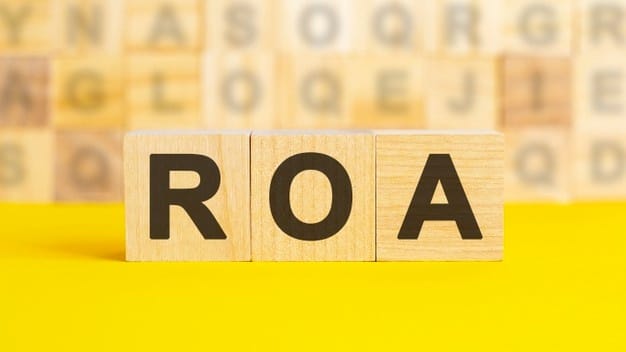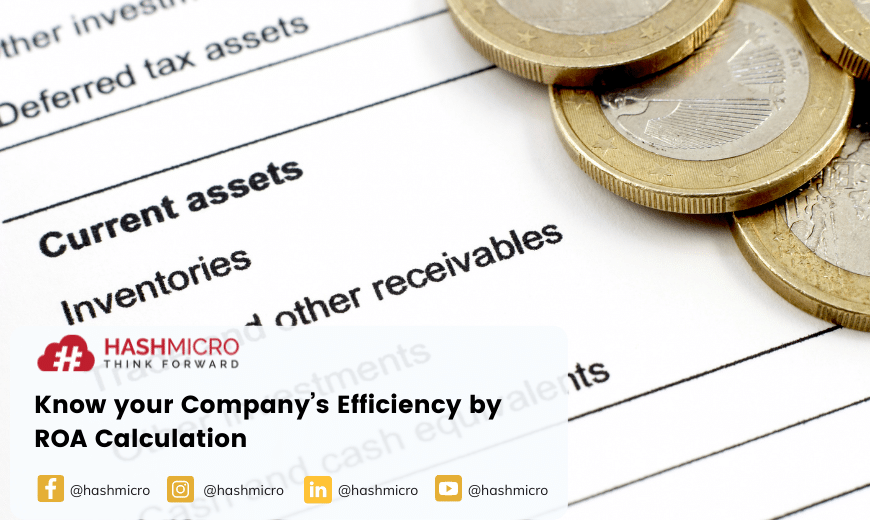To run a business, you must consider both the funds required to achieve sales targets and the profit margin obtained. A company’s financial ratio indicates how well it manages its resources to maximize productivity and profits. It is one of the many financial ratios that can be used to assess a company’s financial performance (ROA).

Return on Assets (ROA) is a profitability ratio that measures a company’s ability to profit from assets. The ROA will assess the company’s ability based on past profit income for the next period. A company’s Return on Assets measures how efficiently money spent on assets are converted into net income. The company can evaluate all operational activities, especially return on investment, by knowing the ROA.
There are currently assets management applications that can manage all company assets, including calculating ROI and costs, among other things. Knowing the level of Return on Assets, or ROA, allows the company to evaluate all operational activities, particularly the level of investment.
Definition of Return on Assets (ROA)
In general, Return on Assets (ROA) is a profitability ratio that measures the efficiency of a company in generating profits from the use of all its resources or assets. Simply put, ROA is the result of a comparison between net income after tax and the total assets that the company has. The ROA ratio statement is a percentage. The higher or good the ROA ratio of the company, it indicates the better the company’s performance in generating net income and vice versa.
The intent of net income in this financial ratio is after-tax profit or in financial statements often referred to as current-year earnings. While the total assets are all the wealth that the company has both sourced from its capital (equity) and debt (debt).
How to Calculate ROA
A company’s business activities vary from time to time. This affects the total value of assets, which changes with the company’s transaction frequency. Throughout the year or period, the company buys and sells assets such as vehicles, land, buildings, and equipment, affecting the overall value of assets. Changes in inventory and seasonal sales also affect the total asset value of a company.
Concerning this, the calculation of the return on total assets will be by the method of comparison of net income available to shareholders with total assets with the formula:
ROA = (Net income after tax: Average total assets) x 100%
In the company’s income statement not all display net income after tax. Some use another term in its naming, namely the current year profit. To get the net profit value after-tax or current year profit, you must first know the company’s gross profit. As for calculating the gross profit, the company can use the following formula.
Gross profit = Net income: Cost of goods sold
After successfully knowing the value of gross profit, then you can further reduce it with all the expenses or costs that the company spends, including tax burdens. That way, it will get the value of net income after tax or current year profit.
Also read: Calculate EBIT to Determine Your Company’s Profitability
The higher the ROA value yield, the better for the company. The value represents the company’s return on all assets. Assume that company X has a net income of 15 million rupiahs. About 50 million rupiahs worth of assets. When using formulas like:
ROA = (15,000,000 : 50,000,000) x 100% = 30%
The higher the percentage, the higher the efficiency of the assets owned.
Benefits of Return on Assets (ROA)
Every company aims to make a profit in running its business. The same goes for shareholders and investors. Therefore, the company and its financiers have the same goal. This, information related to finance is very important for both management and investors, including the value of the ROA ratio.
The ROA ratio helps corporate management determine the company’s policies and strategies for business growth and expansion. For investors, the ROA ratio is useful in determining how well a company converts invested capital into net income.
This financial ratio has various functions that can facilitate company management in evaluating and making policy decisions related to company development. There are five functions of ROA analysis:
- First, the management can use it as a basis for analyzing the efficiency of the company’s capital use, both related to production efficiency and sales efficiency using ROA analysis techniques.
- Second, the company can compare its financial performance to that of its competitors to see if it is better, worse, or equal. So the company can find out its weaknesses and strengths.
Also read: Get to Know about Financial Ratio!
- Third, allocating all costs and capital into related parts can help assess the efficiency and effectiveness of various activities performed by each division so that each division can evaluate its performance and productivity.
- Fourth, using the right product cost system, the company’s management can evaluate the product’s profitability. It can then allocate capital and costs to various products, determining which are profitable and which are not.
- Lastly, ROA is useful for corporate planning. For example, companies looking to expand their business can use ROA to help make decisions. It is also used by investors to make investment decisions.
Advantages Return on Assets (ROA)
ROA has three main advantages. ROA can compare industry ratios. That way, you will know the position of each company in an industry, which is very important in strategic planning. Besides being useful for the sake of control, this analysis is also useful for planning purposes. If the company has carried out accounting practices well then ROA analysis can measure the efficiency of overall capital use which is sensitive to anything that affects the financial state of the company.
Also read: Fixed Asset Definition | Examples, Journal Entries & Acquisition Methods
Disadvantages of Return on Assets (ROA)
In addition to the advantages, ROA also has two main disadvantages. First, the rate at which assets remain depreciating will have a significant impact on ROA. Second, ROA contains considerable distortions, especially in inflationary conditions. Because of the adjustment (increase) in selling price, ROA will tend to be high, while some cost components are still assessed by distortion prices.
Some Factors That Can Affect ROA

The main thing that affects ROA is net profit margin and the total turnover of assets because if the ROA is low, the cause of the profit margin is low due to the lack of total turnover of assets.
Munawir also argues that two factors influence the magnitude of ROA. First, there is the turnover rate of assets from operating profit. Second, the profit margin is expressed as a percentage of total net sales. This profit margin will be used to calculate the amount of profit the company earns, which is then connected to the number of sales.
While profitability is a ratio that evaluates a company’s ability to profit, ROA is one example of a profitability ratio. Other factors that can affect ROA include:
Cash Turnover
Calculating the cash turnover rate reveals the level of efficiency of the company in the business of using an existing cash supply to achieve the company’s goals. Cashmere explained that the ratio of cash turnover or cash turnover is useful to determine the level of adequacy of the company’s working capital that the company needs to pay bills and finance the company’s sales process.
Simply put, this ratio serves to calculate the amount of cash available to pay debt bills and other sales-related expenses.
Receivable Turnover
The turnover rate of receivables can determine the success rate of the credit sales policy in the company. Receivable turnover can be used to calculate how long it will take to collect receivables within a given period or how many times the funds that can be invested in those receivables rotate within a year.
The amount of capital invested in receivables determines whether there is a high or low turnover of receivables. A rapid turnaround in capital indicates that capital returns quickly.
Inventory Turnover
Inventory is a type of current asset that is still classified as an active element in the company’s activities because it continues to be obtained, changed, and then sold to customers. A high inventory turnover rate is necessary to accelerate the cash return from sales.
Inventory turnover as the amount of money stored in rotating inventory for a year. Inventory turnover will help or facilitate the operation of the company, which must be completed on time to produce goods and distribute them to customers. If inventory turnover is high, then the amount of capital needed will be lower.
Conclusion
That’s the full explanation of ROA, including its functions, benefits, and how to calculate it. If you use HashMicro Accounting Software, you will find it easier to calculate ROA. With this application, you will find it easier to complete various accounting processes, such as cash flow statements and financial statements.
This software will also make it easier for you to perform various complex accounting tasks. So, you can quickly record all transactions for your financial statements. Furthermore, you can manage the stock of goods, company assets, and corporate debt instantly. In addition, it can help you quickly and easily monitor your finances anytime and from any location. You can start HashMicro’s Accounting Software demo for free now.














